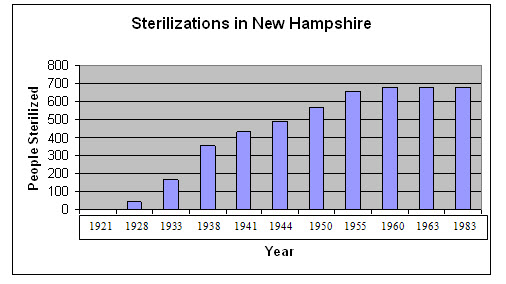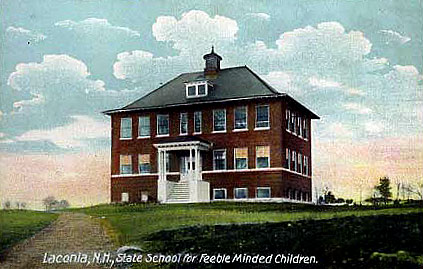New
Hampshire
Number of Victims
The total number of people sterilized under New Hampshire’s sterilization law was 679, of whom 152 were male and 527 (i.e., close to 90%) were female. About 37% of those sterilized were considered mentally ill, and 56% “mentally deficient,” while the remaining 17% belonged to neither category. Given the language of New Hampshire's 1929 sterilization law, this group likely included epileptics (see below).
Period When Sterilizations Occurred
Sterilizations occured between the 1910s until 1959 (Paul, p. 418).
Temporal Patterns which Sterilizations Occurred:

While a comparatively small number of people were sterilized until 1928, between 1928 and 1931, 39 people were sterilized, but the number soared to 80 in 1932, making this the peak year for sterilizations (Paul, p. 418), with 17 people sterilized that year for every 100,000 residents. Between 1933 and 1937, 188 people were sterilized, which results in a number of about 8 people sterilized per operations for every 100,000 residents per year. Thereafter, sterilizations decreased.
Passage of Laws
New Hampshire’s first sterilization law was enacted in 1917, but it was voluntary and not widely used (Paul, p. 415). In 1929, the sexual sterilization act was reenacted as compulsory.
Groups Identified in the Law
The first sterilization law of 1917 provided for the sterilization of the “feeble-minded and patients suffering from certain mental diseases, in institutions and at large” (Stope, p. 537). The 1929 law concerned inmate confined in state institutions “afflicted with hereditary forms of insanity that are recurrent, idiocy, imbecility, feeble-mindedness or epilepsy” (Stone, p. 537).
Process of Law
A portion of the 1929 reenactment states as follows: “Whenever the superintendent of any state or county institution shall be of the opinion that it is for the best interest of the inmate and society that any inmate of the institution under his care should be sexually sterilized, such superintendent is hereby authorized to cause to be performed by some capable surgeon the operation of sterilization on any such inmate [as stated above]” (quoted in Stone, p. 537). Those affected had the right to appeal the sterilization decision to the New Hampshire Supreme Court within 14 days of when the order is issued (Stone, p. 537)
Precipitating Factors and Processes
In 1927 the Supreme
Court case Buck v. Bell was decided
in favor of the
state of Virginia. Around
that time, “the
[Vermont eugenics] advisory committee agreed to promote a sterilization
law and
to study the laws in Maine and New Hampshire” (Gallagher, p. 78). On
April 18,
1929, New Hampshire re-enacted its sterilization law (Stone, p. 536).
Groups Targeted and Victimized
For patients sterilized at the New Hampshire State Hospital (see below) between 1916 and 1935, one researcher found that sterilizations were primarily performed on women of childbearing age (Stone, p. 538). Little else is known about the socio-economic status.
One victim of Laconia
State School
for the Feeble-minded is known: Robert Thomas (Bob) Crawford. A video documentary was
created, based on his
experience there, entitled “Valley of Darkness.” Deemed retarded due to
a severe
head injury he sustained as an infant, he was abandoned by his parents
at
Laconia School for the Feeble-minded at age 8, for economic reasons.
Though not
sterilized, his experiences there shed light on the abusive treatment
of many
individuals who were sterilized a generation before him. He was confined to Baker
residence at
Other Restrictions on the Disabled
The insane and
feeble-minded were
barred from marriage in New Hampshire unless they were sterilized
(Stone, p.
540)
Major Proponents
One proponent was Dr. Charles P. Bancroft, the Superintendent of New Hampshire State Hospital between 1882 and 1917. He was among New Hampshire’s earliest major eugenics advocate and the first in the state to compile heredity data, searching for conditions such emotionalism, hysteria, Huntington's disease and alcoholism. He concluded that genetic factor played a major role in explaining how these disorders arose but conceded the influence of “environmental conditions” (see Stone, pp. 536-7).
Betsy Scott Johnson
was another
proponent for New Hampshire sterilization.
She was a social worker for the
“Feeder Institutions” and Institutions Where Sterilizations Were Performed
 (Photo origin: Rootsweb.org; available at http://www.rootsweb.ancestry.com/~asylums/concord_nh/index.html)
(Photo origin: Rootsweb.org; available at http://www.rootsweb.ancestry.com/~asylums/concord_nh/index.html)
The New Hampshire
State Hospital
in Concord became the institution where the highest number of
sterilizations occurred
up to 1936 (Stone, p. 537). 155
of the
310 operations were performed there. The number of sterilization at the
hospital decreased thereafter compared to Laconia.
By 1947, a total of 170 people had been were
sterilized there (Paul, pp. 415, 418). It is still in operation today.
The State
of New Hampshire’s website provides a 15-page booklet on the history of
the
hospital, which does not mention the hospital’s involvement in eugenic
sterilizations (New Hampshire Department of Health and Human Services).
 (Photo origin: Weirsbeach.com; available at http://www.weirsbeach.com/topten/reason8frame.html)
(Photo origin: Weirsbeach.com; available at http://www.weirsbeach.com/topten/reason8frame.html)
Between 1929 and 1936, 49 sterilizations were performed at “the various county farms of the state” (Stone, p. 537).
Opponents
By the 1950s eugenic
ideology had became
unfashionable among physicians. Dr. G. Donald Niswander, the acting
superintendent for the New Hampshire State Hospital, stated: “I believe
that
this reduction in operations over the years, with the changes in the
hospital
administration, likewise there have been changes in the philosophy
regarding
the sterilization of the mentally ill…if relatives request
sterilization they
urge to take the matter with their family doctor” (Paul, p. 417). In
addition
there was a realization that mental illness also has an important
environmental
component (Stone, p. 537)
Bibliography
Gallagher, Nancy L.
1999. Breeding
Better Vermonters: The Eugenics Project in the
Krumm, Janet M. 1994. "The History of the Laconia State School." The New Hampshire Challenge 7, 1: 1-8.
Lee, Heather. “His Name is Bob: A Documentary Film: Valley of Darkness” (3Frog Productions). Available at <http://www.hisnameisbob.com/>.
New Hampshire Department of Corrections. “State Prison: Lakes Region Facility.” Available at <http://www.nh.gov/nhdoc/index.html>.
New Hampshire Department of Health and Human Services. “History of New Hampshire Hospital.” Available at <http://www.dhhs.state.nh.us/NR/rdonlyres/eqgxy64y5elzzunzesjtrnvgepuoe6kdfyrofkcok5qnizjrowrrayg7jq26zzwl2gez7opwki4er5ruojzo4zszdcd/History+of+NHH.pdf>.
Paul, Julius. 1965. “State Eugenic
Sterilization
Laws in American Thought and Practice:
Stone, Simon. 1936.
“Sexual
Sterilization in